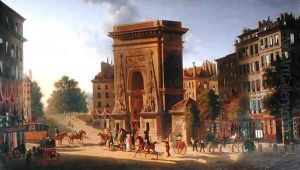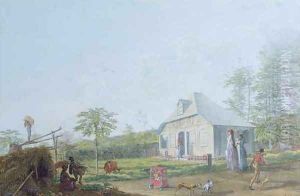Jean-Joseph Patu de Rosemont Paintings
Jean-Joseph Patu de Rosemont was a prominent figure in the world of French art, born in 1767. His life and career were marked by the rich cultural and political upheavals of his time, navigating the complexities of the late 18th and early 19th centuries. Despite the challenges of the era, Rosemont managed to carve a niche for himself in the art world, primarily through his exquisite landscape paintings and detailed sketches that captured the essence of his surroundings with remarkable sensitivity and skill.
Rosemont's early life was steeped in the artistic traditions of France, which greatly influenced his development as an artist. He was born into a period where the artistic scene was dominated by the Rococo style, which was gradually giving way to Neoclassicism. This transition between styles provided a fertile ground for Rosemont's artistic exploration, allowing him to experiment with and eventually adopt elements from both movements in his work. His landscapes, in particular, reflected the Neoclassical emphasis on harmony, proportion, and the importance of drawing from classical antiquity, albeit through the prism of his unique perspective.
Throughout his career, Jean-Joseph Patu de Rosemont exhibited a profound connection to the natural world, which became the central theme of his oeuvre. His paintings often depicted serene and idyllic landscapes that seemed untouched by the turmoil of the era. This was a time when France was undergoing dramatic changes, from the Revolution to the Napoleonic Wars, and yet Rosemont's art offered a tranquil refuge from the chaos. His ability to capture the beauty and tranquility of nature, with an almost poetic sensitivity, earned him recognition and appreciation among art lovers and critics alike.
Despite his talent and contributions to the art world, Jean-Joseph Patu de Rosemont's name is not as widely recognized today as some of his contemporaries. His death in 1818 marked the end of a career that had navigated through one of the most turbulent periods in French history. However, for those who delve into his works, Rosemont offers a unique window into the era's landscape art, characterized by its blend of realism and idealism, its reflection of contemporary societal changes, and its profound appreciation of natural beauty. His legacy, though understated, continues to be appreciated by art historians and enthusiasts who recognize his role in the development of landscape painting in France.


